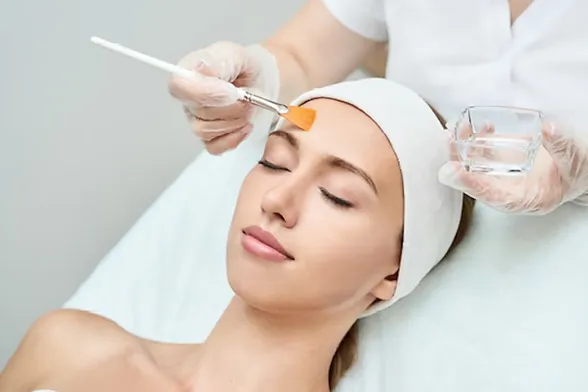Getting Ready for Your Chemical Peel Treatment
A chemical peel is a well-known skin treatment that can refresh your skin’s look. The treatment uses a chemical solution. This solution helps remove the top layer of skin cells. This process gently gets rid of dead skin, which can help with different skin issues. It can make your skin look better by reducing fine lines, age spots, and acne scars.

Key Highlights
- Chemical peels help with fine lines, wrinkles, acne scars, and uneven skin tone by taking off damaged top layers.
- This treatment uses a chemical solution to gently remove the skin’s surface. This reveals a fresher layer beneath.
- There are different types of chemical peels. They can be superficial peels, medium peels, or deep peels. Each one is meant for different skin issues.
- It is important to talk to a qualified dermatologist or plastic surgeon. They can help you choose the right type of peel for your skincare goals and skin type.
- Taking care of your skin before and after treatment is very important. This will help you get the best results and avoid risks like color changes in the skin or scarring.
What Are Chemical Peels and How Do They Work?
Chemical peels are getting more popular. They are a non-invasive way to make skin look fresh and new. This treatment can help with many skin issues. It can reduce fine lines and wrinkles, treat acne scars, and improve uneven skin color. Chemical peels work by taking away the damaged top layers of skin (the stratum corneum). This helps the skin make new collagen and skin cells. The result is skin that feels smoother and looks brighter.
But, like any beauty treatment, you should think carefully about it. It’s important to talk with a board-certified dermatologist or plastic surgeon. They can help you decide if a chemical peel will meet your needs. They will also check if it is a good choice for your skin type and medical history.
The Types of Chemical Peels: Light, Medium, and Deep
The world of chemical peels has many choices for different skin issues. You can mainly find three types: superficial peels, medium chemical peels, and deep chemical peels. Each type uses different chemicals to go into various depths of the skin. This means they will give different results.
Superficial peels, or “lunchtime peels,” are gentle. They use mild acids like alpha-hydroxy acids. These peels help with fine lines, uneven skin tone, and acne. They do not need much recovery time.
Medium chemical peels go deeper into the skin, reaching the middle and outer layers. They use acids like trichloroacetic acid or glycolic acid. These peels help reduce age spots, acne scars, and wrinkles but need some downtime.
Deep chemical peels use stronger acids like phenol or trichloroacetic acid. They go deep into the middle layer. These peels can give the most dramatic results. They can fix deep wrinkles, sun damage, and even precancerous growths. However, they require the longest recovery time.
Preparing for Your First Chemical Peel
Preparing for your first chemical peel is easier than you might think. First, choose a skilled skincare expert, like a dermatologist or plastic surgeon with years of experience in chemical peel procedures. Talk about your skin concerns, medical history, and what you want to achieve.
It is important to follow your doctor’s advice before the cosmetic treatment. This may involve staying out of direct sunlight, avoiding some skin care products (especially those containing vitamin A or retinoid cream), or not taking certain medicines. Doing this helps your skin be ready for the peel and reduces the risk of skin irritation, particularly for those with sensitive skin.
Initial Consultation: What to Expect
Before you start your chemical peel journey, it’s very important to meet with a qualified provider. This meeting is not just to book the procedure. It helps create a personalized treatment plan designed for your needs and goals.
During this meeting, you will talk in detail about your medical history, your skin issues, and what you want to achieve. Make sure to mention any allergies, medications, or past plastic surgery. The provider will assess your skin type and the level of your concerns. They will then suggest the best chemical peel type and strength for you. This may involve a peeling process using hyaluronic acid, vitamin C, or other active ingredients.
This meeting is also a chance for you to ask any questions or raise any worries. You should feel comfortable asking about the procedure itself, what recovery looks like, the risks and benefits, and how to care for your skin after. This way, you will know all you need and feel confident during your chemical peel treatment.
Pre-Treatment Skin Care Regimen
Preparing your skin for a chemical peel is very important for getting optimal results. Your dermatologist or plastic surgeon will suggest a skincare routine just for you. This plan will depend on your skin type and the kind of chemical peel you will have. It may include the use of facial masks to further prepare your skin.
Besides the personal plan, there are some basic rules you should follow. For example, you need to avoid excessive sun exposure for at least two weeks before your peel. Too much sun can make your skin extra sensitive and raise the chances of complications. Your dermatologist might also give you antiviral medication. This is especially important if you have had cold sores or herpes before, as peels could cause outbreaks.
The Chemical Peel Process
If you are thinking about a chemical peel, knowing what happens can help calm your nerves. Usually, this procedure is easy to manage and done in a clinic where you don’t stay overnight. First, your face will be cleaned, and then a chemical solution made for your skin and goals will be applied carefully. The solution stays on your skin for a set time and helps safely remove the top layers. This process uncovers fresher and smoother skin beneath. You might feel a slight tingling or warmth while the chemical solution is on your skin, depending on the type of peel.
Step-by-Step Guide to the Procedure
A chemical peel is usually done as an outpatient procedure. This means you don’t need to stay in the hospital overnight. The steps may change a bit based on your needs and the type of peel. Here’s a simple guide:
- First, the aesthetician or dermatologist will clean your face very well. This helps remove any makeup, oil, or dirt.
- Then, they will put on a chemical solution. This could be glycolic acid, trichloroacetic acid, salicylic acid, or another type. It depends on your skin’s problems and the peel you need.
- After applying the solution, it will stay on your skin for a set time. This time is based on how your skin reacts and the results you want. You might feel a slight tingling or warming feeling during this time.
- Lastly, they will neutralize and remove the solution. They may then use a soothing ointment or cream. This helps reduce discomfort and aids in healing.
During the Treatment: Sensations and Immediate Care
During a chemical peel, you may feel different sensations as the chemical solution works. You might notice a mild tingling, warmth, or a slight stinging sensation when the solution is applied. How intense these feelings are can change based on the type of peel and how much pain you can handle. For deep peels, which are stronger, some people may need sedation or local anesthesia.
To help with any discomfort during the procedure, you might get a cool compress or a hand-held fan. Sometimes, a blue or violet dye is added to the solution. This makes it easier to apply the solution evenly.
After the peel, the focus is on reducing discomfort and helping your skin heal. The treated area might look red and a bit swollen, but this is entirely normal and will go away slowly but surely. Your dermatologist will give you specific instructions for care after the peel. This may include using soothing ointments, keeping the area clean, and applying sunscreen regularly.
Post-Treatment Care and Recovery
Post-treatment care after a chemical peel is very important for healing. Your dermatologist will give you specific instructions. Generally, you will need to keep the treated area moisturized with proper hydration. You should also protect it from the sun. You may also need to avoid strenuous exercise or activities that lead to excessive sweating.
The recovery time varies based on the type of chemical peel you have. Superficial peels usually have little downtime, while deeper peels may need one to two weeks for recovery. Following all the instructions from your dermatologist, including drinking lots of water or plenty of water, helps ensure a good healing process and reduces any risks or problems. These are important steps to ensure you get the most out of your skincare treatments and achieve a healthy, glowing complexion.
Remember, if you are considering hair removal in conjunction with a chemical peel, discuss this with your dermatologist during your initial consultation. They can advise you on the best timing and approach to minimize any potential skin irritation.
Potential Risks and How to Mitigate Them
Chemical peels are mostly safe but come with risks and side effects. Choosing a skilled and experienced dermatologist or plastic surgeon is very important to lower these risks.
Talk openly about your medical history, skin issues, and any medicines or supplements you use. This helps your doctor create a treatment plan that fits you and spot any possible risks. Following the doctor’s instructions before and after the treatment is key for safe and good results.
Common Side Effects and Their Management
Feeling some side effects after a chemical peel is normal. How much you feel them varies by how deep the peel is and how sensitive your skin is. Common side effects are redness, dryness, peeling, swelling, and a stinging or burning feeling. These usually go away in a few days to about a week.
Some people may notice changes in their skin color. This can be hyperpigmentation, which is the darkening of the skin, or hypopigmentation, which is the lightening of the skin. These changes may not last long, but in some cases, they can be permanent. The chance is higher for those with darker skin types.
Follow your dermatologist’s care instructions closely after treatment to deal with side effects. Stay away from sun exposure, use the ointments or creams they suggest, and keep your skin moisturized. This will lessen discomfort and help with healing.
If it’s your first time or you do it regularly, talking to experts is important for safety and success. You must understand the different peels, the risks involved, and how to care for your skin after the treatment to get good results.
To get the best results, consult with an agency or med spa like Vanishing Ink Med-Spa. This way you work with a center that can provide the resources and guidance you need from the beginning to the end so you don’t have to go through any part of the process we’ve mentioned blind.
You can book an appointment with us online and get started today.

